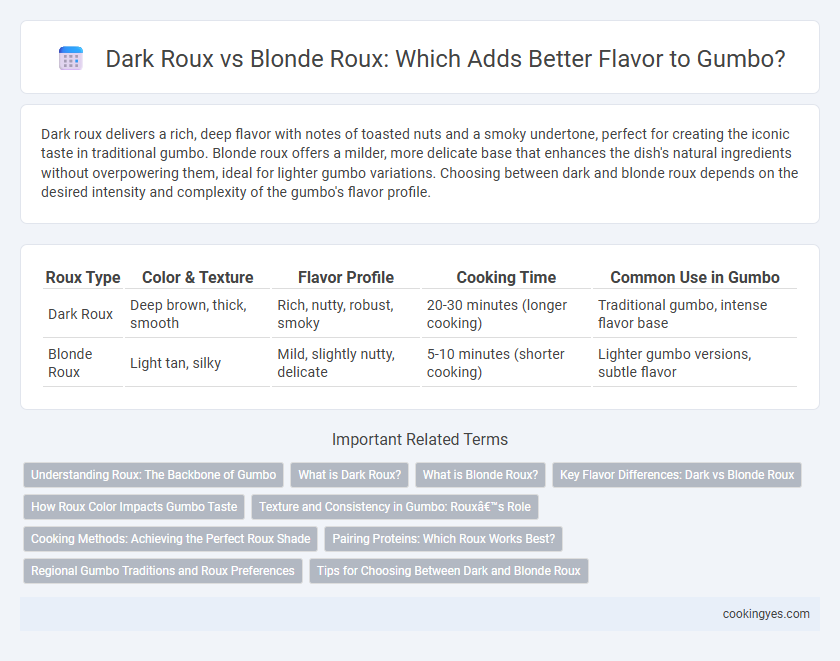Dark roux delivers a rich, deep flavor with notes of toasted nuts and a smoky undertone, perfect for creating the iconic taste in traditional gumbo. Blonde roux offers a milder, more delicate base that enhances the dish's natural ingredients without overpowering them, ideal for lighter gumbo variations. Choosing between dark and blonde roux depends on the desired intensity and complexity of the gumbo's flavor profile.
Table of Comparison
| Roux Type | Color & Texture | Flavor Profile | Cooking Time | Common Use in Gumbo |
|---|---|---|---|---|
| Dark Roux | Deep brown, thick, smooth | Rich, nutty, robust, smoky | 20-30 minutes (longer cooking) | Traditional gumbo, intense flavor base |
| Blonde Roux | Light tan, silky | Mild, slightly nutty, delicate | 5-10 minutes (shorter cooking) | Lighter gumbo versions, subtle flavor |
Understanding Roux: The Backbone of Gumbo
Dark roux and blonde roux serve distinct roles in gumbo, with dark roux imparting a rich, deep, nutty flavor while blonde roux offers a lighter, more subtle base. The backbone of gumbo relies on the precise cooking of flour and fat, where longer cooking times develop complex flavors in dark roux, crucial for traditional Creole and Cajun dishes. Mastering the texture and color of roux directly influences the gumbo's depth and authenticity, making it essential to balance flavor intensity with the desired outcome.
What is Dark Roux?
Dark roux is a rich, deeply browned mixture of flour and fat cooked slowly until it attains a chocolate color, providing gumbo with its characteristic robust, nutty flavor and thickening power. It requires careful attention to avoid burning while developing complex, smoky undertones that distinguish gumbo from other stews. The longer cooking time of dark roux enhances the depth and richness, making it essential for authentic Creole and Cajun gumbo recipes.
What is Blonde Roux?
Blonde roux is a mixture of flour and fat cooked just until it develops a light golden color, providing a subtle, nutty flavor with less bitterness compared to darker roux varieties. In gumbo, blonde roux offers a delicate base that enhances the dish's complexity without overpowering other ingredients. Its lighter texture helps maintain a smoother consistency, making it ideal for those who prefer a milder gumbo flavor.
Key Flavor Differences: Dark vs Blonde Roux
Dark roux brings deep, smoky, and nutty flavors with a slightly bitter undertone, intensifying the gumbo's richness and complexity. Blonde roux offers a milder, toasted flavor with a subtle sweetness, preserving a lighter, more delicate gumbo profile. The choice between dark and blonde roux significantly impacts the gumbo's depth and balance, shaping its traditional character.
How Roux Color Impacts Gumbo Taste
Dark roux imparts a deep, nutty flavor to gumbo and offers a richer, more complex taste profile, while blonde roux provides a lighter, more subtle base allowing the other ingredients' flavors to stand out. The longer cooking time for dark roux develops caramelization and bitterness that enhance gumbo's depth but reduces thickening power compared to blonde roux. Choosing roux color directly impacts gumbo's texture and flavor intensity by balancing richness and ingredient clarity.
Texture and Consistency in Gumbo: Roux’s Role
Dark roux imparts a rich, nutty flavor and thicker consistency to gumbo, creating a robust texture that clings well to ingredients. Blonde roux offers a lighter, smoother texture and more subtle flavor, resulting in a thinner, silkier gumbo base. The choice between dark and blonde roux directly influences gumbo's mouthfeel and how its flavors meld together.
Cooking Methods: Achieving the Perfect Roux Shade
Dark roux requires slow, continuous stirring over low heat for 30 to 45 minutes to develop deep, nutty flavors without burning, crucial for authentic gumbo richness. Blonde roux is cooked at a slightly higher temperature for 10 to 15 minutes until a golden color appears, offering a milder, more delicate base ideal for lighter gums. Mastering the cooking time and temperature directly impacts the roux's flavor complexity and the gumbo's overall depth.
Pairing Proteins: Which Roux Works Best?
Dark roux offers a deep, smoky flavor that pairs exceptionally well with robust proteins like sausage, duck, or game meats, enhancing gumbo's hearty character. Blonde roux provides a milder, nutty taste that complements delicate proteins such as chicken, shrimp, or crab, allowing their natural flavors to shine without overpowering. Selecting the roux based on protein ensures optimal balance and flavor depth in traditional gumbo recipes.
Regional Gumbo Traditions and Roux Preferences
Dark roux, favored in Cajun gumbo traditions of Southwest Louisiana, offers a deep, nutty flavor and thicker consistency essential to hearty Cajun dishes. In contrast, Creole gumbo from New Orleans often uses a blonde roux, prized for its lighter color and subtle, slightly toasted flavor that complements the dish's tomato base and seafood ingredients. Regional preferences highlight dark roux for robust, rustic gumbo and blonde roux for delicate, refined flavors, shaping the characteristic taste profiles of their respective gumbo styles.
Tips for Choosing Between Dark and Blonde Roux
Dark roux offers a rich, deep flavor with nutty undertones ideal for traditional Cajun gumbo, while blonde roux provides a milder taste and thicker texture suited for lighter, seafood-based gumbo recipes. When choosing between dark and blonde roux, consider the gumbo's main ingredients and desired intensity--dark roux complements heartier meats like sausage or chicken, whereas blonde roux enhances delicate seafood flavors without overpowering them. Monitor cooking time and heat carefully to avoid burning a dark roux, and opt for blond roux when aiming for a smoother, less bitter base.
Dark roux vs blonde roux for gumbo flavor Infographic

 cookingyes.com
cookingyes.com